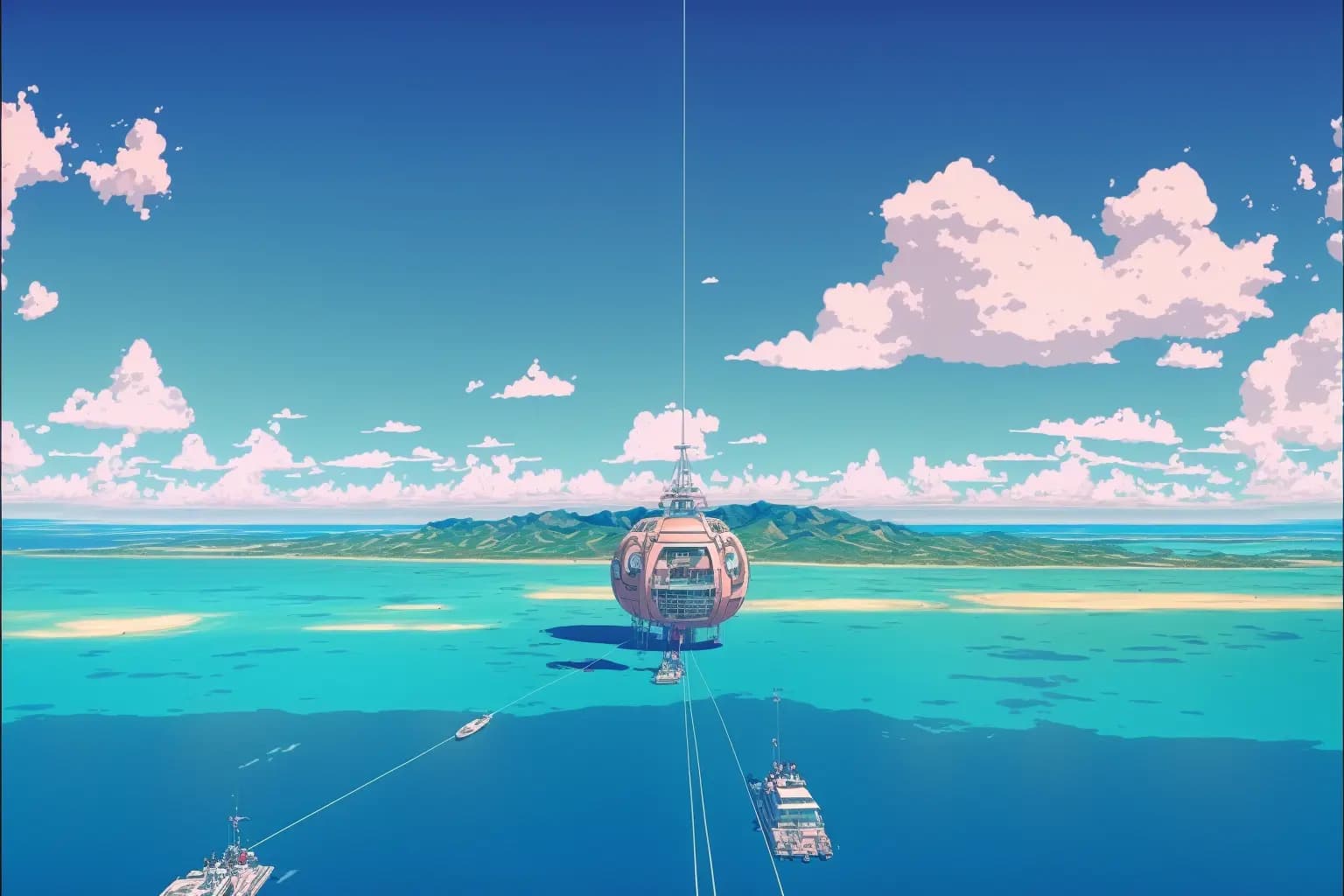🛰️ Liu Cixin's technologies of the future
Written Jan 12, 2023. Discuss on Hacker News.
⚠️ Disclaimer: Contains light spoilers about the books' universe. Probably do not read if you plan to read « The Dark Forest » soon. Oh and I have no scientific background, this is pure observations of interesting ideas.
I recently finished the book The Dark Forest by Liu Cixin. It's now one my favorite sci-fi books.
An advanced alien civilization discovers Earth as an alternative to their dying world, prompting them to embark on a centuries-long interstellar voyage to our planet.
The sequel to the Three Body Problem goes on to describe what happens on Earth, including the technological development to anticipate the alien arrival.
I liked the technological concepts proposed by Liu Cixin, as many of them are not too far-fetched in light of our current scientific understanding.
Here are some interesting ones.
Space elevator for low-cost space access

It's a crazy concept, but it's being seriously studied.
While it could cost $10+ billion to build, it would reduce the cost of putting things into orbit from ~$7,000 per kg today to as little as ~$50 per kg.
Basically we'd have a satellite in geostationary orbit with a tether inside, like a tape measure. The tether would be extended up into space and down towards the Earth’s equator at the same time, keeping a balance between the two.
On Earth, the station could be made mobile (ship on the ocean) to work around hazards like lightning, wind, hurricanes, space debris, and meteorites.
One challenge is in the strength of the cable – scientists believe that carbon nanotube material could be the answer.
Preliminary work seem to be underway.
| Material | Tensile strength (MPa) | Density (kg/m3) | Specific strength (MPa)/(kg/m3) |
|---|---|---|---|
| Steel | 5,000 | 7,900 | 0.63 |
| Kevlar | 3,600 | 1,440 | 2.5 |
| Carbon nanotube | 130,000 | 1,300 | 100 |
One company in Japan, Obayashi Corporation, reportedly started working on one following a breakthrough with carbon nanotubes (CNTs).
Aneutronic fusion spacecraft propulsion

A spacecraft propulsion system that utilizes aneutronic products of nuclear fusion directly as the exhaust jet would bring us closer to deep space.
From what I gather, this seems to be about the best propulsion method we could achieve with our current theoretical physics framework.
I found this report written at NASA: Aneutronic Fusion Spacecraft Architecture.
Some extracts:
It can be easily argued that the most important factor in drastically changing the paradigm of space exploration is the development of a new, radically more effective in-space propulsion system. Every other technology development would appear merely incremental compared to that of a new propulsion paradigm that, for any given payload, could increase the ratio of mission distance to trip time by a factor of ten or more.
[…] A fusion reactor with net power production capabilities has yet to be demonstrated, but fusion is no longer an exotic technology. It has reached a high level of scientific and technological maturity through a half-century of remarkable progress.
[...] In order to achieve game-changing mission capability a stand-alone aneutronic fusion reactor is not sufficient, nor is it enough to develop only an efficient advanced (electric) thruster. A deep integration of spacecraft power and propulsion management is required. Thus, to reach this goal, the proposed research is investigating the feasibility of a system that allows direct conversion of the products of aneutronic fusion reactions into useful thrust.
[...]The proposed architecture approximates an ideal propulsion scheme, wherein a high-density primary energy source directly ejects mass (the propellant) in the direction of thrust. This concept is based on aneutronic nuclear fusion as the high-density primary energy source. Some energy is then extracted from the fusion reaction products via direct energy conversion to recirculate power as required for the operation of the fusion core. The remaining flow of reaction products is ejected into space for producing the required propulsive thrust. At this final stage, the ejected beam will have been conditioned to achieve the actual values of thrust and specific impulse that are required for a given phase of the mission profile.
[...]A new propulsion paradigm that enables faster and extended space travel is arguably the technology development that could have the largest impact on the overall scope of the NASA mission, essentially enabling the most defining and important aspect of the agency’s role.
Common use of hibernation as a form of time travel

People are frozen at -50°C and their body fluids replaced by a special cryoliquid, allowing machines to take over their cardiovascular functions and organs to slow to a minimum.
Some opt for hibernation to seek a cure for an incurable illness, while others are sent to lead long-term projects or explore. Though this technology raises moral issues related to the wealthy seeking immortality, these are easily forgotten when the future starts looking grimmer.
Today, the closest we have seems to be Deep Hypothermic Circulatory Arrest (DHCA).
Body temperature is reduced to 20-25°C and blood circulation and brain function are stopped for up to an hour. It's used when blood circulation to the brain needs to be stopped for delicate surgery, or when surgery is needed on large blood vessels leading to or from the brain. DHCA is a form of carefully managed clinical death and can be tolerated for up to 60 minutes in infants, but only 40 minutes in adults.
Devices powered by ambient electricity fields

Wireless charging is already a reality, but what if we could take it to the next level?
Could we power all of our electronic devices, from phones to cars, with ambient fields, doing away with batteries and charging plugs?
While the technology has been around for a while, the power-loss over any significant distance is simply too high.
Could fusion energy and improved device efficiency make this a viable option? I also wonder about potential health effects to consider.
Breathing fluid for high-G space travel

Without our ability to withstand high G-forces, manned space exploration would stay limited and unable to reach farther, more exciting destinations.
Depending on the duration, a typical person can handle ~5G before passing out, but with a G-suit and training, fighter pilots can sustain ~9G.
Liquid immersion provides a way to go higher and is used in the Libelle G-suit which can handle up to 15-20G.
To go beyond 20G, one solution might be to fill astronaut's lungs with a fluid allowing acceleration forces to be distributed equally and simultaneously in all directions.
Finding a breathing medium of similar density to water that is compatible with lung tissue seems to be difficulty here.
Dynamic display clothing

An intriguing idea: in the future, everyone is wearing clothing that changes colors to showcase emotions with dynamic, abstract images.
Whether it's a soothing sunset, darker hues when you're not feeling up to conversation, or multicolored patterns at a party, this would be a great way to either stand out or blend in a crowd.
Or you can just project a jean texture and be done with it.
This might also be seen as a continuation of the current trend of sharing one's life on Instagram Stories.
Technically this does kinda already exist.
Capturing gas from Neptune to restore Earth's ozone layer

After climate change left much of the Earth's surface barren and uninhabitable, a mission is launched to bring back hope of restoring the planet's climate.
Huge spaceships are sent to harvest gas from Neptune, with the intent of releasing it into the atmosphere, restoring some of the ozone layer and cooling down the Earth.
Despite the lack of details and all the obvious difficulties, I found this one also intriguing.
--
All images generated with Midjourney.